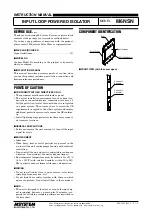
rev. 3/24/2014
LOW, manual.doc
Copyright 2014 Vestil Manufacturing Corp. 8 of 10
iii. Load hook latch: inspect the hook latch in accordance with ANSI/ASME B30.10. The
latch should be straight and sound, without deformation. Its attachment to the hook
should not be loose. The latch should quickly snap against the tip of the hook when
released.
Periodic Inspection:
At least once per year (once every 6 months for chain blocks in heavy service or 3 months for severe
service chain blocks), inspect the chain block and trolley for the following; correct/repair any problems
identified during the most recent inspection:
a. Perform a “Frequent Inspection”
b. Evidence of loosening fasteners: check bolts, nuts, washers, etc. Make sure that
connections are tight.
c. Evidence of wear, corrosion, cracks, or deformations of operational components: examine
track rollers, pinion, suspension shafts, suspension block, all pins, chains, chain
attachments, gears, bearings and the housing pieces.
d. Evidence of damage to hook, hook retaining hardware, and end connections of load chain.
e. Evidence of damage to or significant wear sprockets and wheels (inside chain block
housing): inspect the hand chain wheels, load sprockets, and idler sprockets.
f. Condition of warning labels: labels, plates, and tags should be easily readable and affixed or
attached to the chain block system as shown in the label placement diagram on p. 9.
NOTE:
Label appearance and content is subject to change over time, and consequently,
replacement labels might differ from labels shown in the manual supplied with the unit.
Maintenance:
Always unload the chain block and trolley before performing maintenance on them.
To maximize the service life of the chain block and trolley, routinely clean and lubricate them.
1) Cleaning: clean the following components with an acid-free solvent at least once per year. Heavy usage
requires more frequent cleaning.
a. Load Chain (chain block)
b. Hand Chain (trolley)
c. Hand Chain (chain block)
d. Load
Hook
e. Track Rollers (chain block)
f. Suspension
Shafts
g. Pins and Fasteners
2) Lubrication: [NOTE: Roller bearings of the trolley are sealed and require no lubrication.]
a. Load Chain (chain block) - lubricate the load chain at least once every 3 months. Lubricate the
chain with industrial general lithium grease (NLGI No. 0). If the chain block is used in dusty
environments, dry lubricant can be used. It is particularly important that lubricant be applied to the
surfaces of the chain that contact the load sheave.
b. Load Sheave (of chain block) - Apply lubricant to the pockets of the load sheave as well.
c. Pinion & Geared Track Rollers (trolley) – Apply EP1 grease or the equivalent if the usage
environment temperature is in the range from -20°F to 50°F. EP2 grease is appropriate for
temperatures from 30°F to 120°F. Apply lubricant to the contact surfaces as frequently as
necessary to ensure that all teeth are thoroughly covered.
d. Fasteners and pins – Lubricate fasteners and pins, especially threaded surfaces, with appropriate
lubricants (e.g. anti-seize compound or thread lubricant).




























